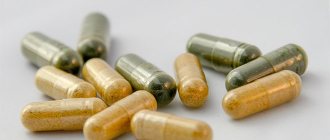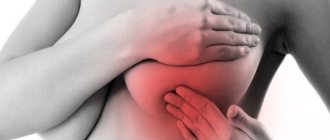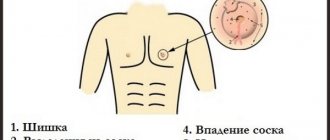In medical practice, there are many cases when the temperature rises during lactostasis. In addition to the painful sensations that arise during the feeding stage, the woman begins to worry about one more question. On the one hand, it is necessary to eliminate the cause that provoked the increase in body temperature as quickly as possible; on the other hand, doctors do not recommend using potent drugs throughout the entire period of feeding.
General concept of lactostasis
Lactostasis is characterized by a violation of the outflow of milk and its stagnation in the milk ducts of the mammary gland. This phenomenon can occur in any lactation period, but most often occurs in the following cases:
- with systematic and abundant flow of milk;
- after birth on the first or third day;
- after a lactation crisis (3 weeks, 1.5 months, 3 months);
- improper attachment to the breast, feeding in one position;
- temporary refusal of the child to breastfeed (the child is sleeping, not hungry or sick);
- wearing a tight and constricting bra;
- due to improper completion of lactation (tight breast ligation, weak expression of residual milk);
- mastopathy.
Often, lactostasis is an obstacle to normal breastfeeding. Thus, the intimate and secret area of the female body is subjected to difficult tests, which overshadow the very process of latching the baby to the breast. In addition to acute and aching pain, there are other not very encouraging symptoms:
- increased body temperature (often above 38-39 degrees, sometimes low-grade fever);
- chills, lethargy, drowsiness;
- symptoms of intoxication – nausea, dizziness;
- the skin in the painful area is hyperemic, sometimes bluish;
- On palpation, compaction is noted.
Chest pain with lactostasis can be of varying intensity and completely depends on the severity of the disease. Most often, a woman notices a tingling sensation in the chest (a place of stagnation), which intensifies during feeding. The nipple, the entire breast, the armpit, and the shoulder may also hurt.
Symptoms
Symptoms of the disease include:
- formation of lumps in the breast;
- feeling of heaviness, unpleasant and painful sensations when pressing;
- redness of the skin, breasts become hot;
- fever, a painful condition that can develop into fever.
It is important to know: lactostasis easily turns into mastitis, and therefore it is necessary to “catch” the disease at the very beginning, otherwise its treatment may be delayed.
Lactostasis is often accompanied by a painful condition and allergic symptoms: watery eyes, runny nose. This is due to the onset of inflammatory processes and the body’s desire to get rid of the virus on its own. If you do not respond in time, the inflammation will quickly grow and turn into mastitis.
Has the temperature on the thermometer gone up? Don't panic!
An increase in body temperature is not always the first sign of lactostasis. This symptom is also characteristic of other pathologies, so before fighting lactostasis, it is recommended to evaluate other signs. It must be remembered that a nursing mother is more susceptible than ever to various diseases, such as ARVI, bacterial infection, poisoning, and exacerbation of chronic pathologies. All of the above diseases can also cause fever, so they must be excluded. Naturally, this should be done by a doctor.
In no case should you self-medicate, as many medications may be useless, and they can also pass into breast milk and negatively affect the baby. Therefore, if you suspect a number of diseases, it is necessary to consult a therapist within the first days after an increase in body temperature, and if there are signs of lactostasis, consult a mammologist.
Every month for up to a year, each mother takes her baby to the children's clinic for a preventive examination. Surely there is a specialist in the children's medical institution who will help you understand the problem. Perhaps due to improper application or for another reason, the development of lactostasis is observed.
A qualified worker, after looking at the process of feeding and breastfeeding, will help eliminate errors and give additional recommendations. For example, he will recommend exactly the position in which the milk ducts will be maximally opened. This can be a feeding position “on all fours” or lying on your side and offering the baby the opposite breast. Do not be afraid of these methods: they are temporary and must be continued until the symptoms alleviate. Consequently, when lactostasis is removed, the temperature reaction should soon disappear.
Other ways to reduce fever
If, with lactostasis, the thermometer shows 39 or higher, and the drugs help slowly and weakly, it is necessary to regularly wipe with vinegar water. You need to wipe your forehead, elbows, knees, and also the armpit area. It is advisable to make a compress on the forehead: constantly moisten a cotton cloth or rolled gauze in cold water as it warms up.
An important step in the treatment of mastitis and reducing body temperature is local compresses on the affected mammary gland. A cabbage leaf helps a lot, which must first be beaten so that the inner side releases juice. The sheet is placed on the mammary gland, and a cotton bra that is not too tight is put on top. This procedure should be done at night, and the compress should be removed in the morning. If the fever persists and does not subside, you should consult a doctor.
Is it possible to lower the temperature during lactostasis?
Lactostasis, as a rule, is combined with elevated temperature, which can reach different marks on the thermometer. The criticality of a woman’s condition directly depends on the severity of the disease and the characteristics of the body. Thus, with mild blockage, low-grade fever may be observed, while more acute and severe pathological processes cause an increase of 38.5-39 degrees and higher.
It is very important for nursing mothers to measure their body temperature correctly. Many people mistakenly place a thermometer in the armpit and thus get an unreliable result.
Important! Body temperature is measured in the elbow bend! The fact is that the armpit borders the breast, which, when inflamed, becomes much hotter, which is why the result is distorted.
Often, nursing mothers who are faced with insidious mastitis ask the doctor: “Is it possible to lower the temperature, and how?”
As with other diseases that are characterized by fever, it is recommended to fight the fever at a level of at least 38 degrees. In cases where the temperature rises above 38-39 degrees, treatment without antipyretics is impossible and even dangerous.
You can bring the readings on the thermometer back to normal with the help of medications and folk remedies. In this case, it is necessary to take into account an important fact: use only those drugs and products that are approved for use during breastfeeding!
When it comes to medications, it is best to choose those with the active ingredients ibuprofen or paracetamol. It would be ideal if these are rectal suppositories, because they are minimally absorbed into the blood and, accordingly, a tiny amount of the drug ends up in the milk. The disadvantage of treatment is that suppositories are usually designed for children, so adults will have to adjust the dosage.
You can also use baby Aspirin to reduce the reading on the thermometer. However, there is also a drawback: relief does not come quickly, and the effect of the drug is short-lived.
It is unacceptable to lower the temperature during lactostasis with pharmaceutical products, popularly referred to as “four tablets”, “fizzy drink” and “hot tea”. The main active ingredient is absorbed into milk and has a negative effect on the child.
Treatment and recovery
In order to keep the temperature during lactostasis at an acceptable level, it is necessary to strictly follow all the doctor’s recommendations. They primarily concern the correction of daily routine and nutrition. The key to success is foods and types of physical activity that prevent the formation of swelling. The relationship here is quite simple. The less tissue swells, the greater the likelihood of avoiding stagnation of milk in the glands.
Separately, the specialist will dwell on those actions that are strongly recommended to be performed for the benefit of the baby. Quite often you can hear a common stereotype that an increase in body temperature during lactostasis to 38-40°C is tantamount to a ban on feeding. Doctors do not recommend trusting such fabrications. It is easy to understand that the cause of the deterioration in health was stagnant processes in the mammary glands.
The more actively the mother breastfeeds the newborn, the faster congestion in the mammary glands will disappear. It is strongly recommended to empty the mammary glands as much as possible. Only in this case will the unpleasant clinical manifestations disappear quickly enough. The main thing is to correctly determine which breast is inflamed. It is to this that you need to apply the baby more often than usual.
In addition to the listed practical recommendations, doctors highlight several more tips to improve your health:
- feeding is done in the most comfortable position for the lady;
- after completing the feeding procedure, it is necessary to express the remaining milk without fail;
- A warm shower taken before expressing can greatly facilitate this process;
- patients should remember that temperatures elevated to 39 ºС and above are a direct prohibition regarding any thermal procedures;
- Another way to make pumping easier is to gently massage.
Separately, doctors dwell on the correctness of taking antipyretic drugs. These should be drunk only after consulting a doctor. The doctor will tell you about the required duration and dosage. At the same time, mom will give one more vital piece of advice. If you cannot lower your temperature on your own within 2 hours, you must call an ambulance.
It is strictly forbidden to make attempts to restore the natural temperature background if this was not possible within the above period of time. The risk of irreversible pathological changes in the mother’s body increases significantly.
After hospitalization, doctors will conduct a professional examination to determine the actual reasons for the increase in temperature during lactostasis.
Folk remedies
Do not forget about folk methods of relieving fever, many of which are allowed for nursing mothers. The most common and effective thing you can do is wipe with household vinegar. It is dangerous to use in its pure form, so dilute it with warm water (a tablespoon of bite per glass of water).
A clean cloth should be dipped into the resulting solution and squeezed out. Wipe those areas of the body where there are important vascular plexuses: elbow and knee bends, wrists, calf areas, behind the ears. It is better not to treat the skin in the armpits, since the mammary glands are located nearby, into which a small amount of vinegar can enter through the bloodstream.
Rubbing with alcohol is effective, but is strictly prohibited for nursing women! The fact is that alcohol is actively absorbed through the skin into the blood and, accordingly, into milk. A baby who is then put to the breast may get alcohol poisoning.
Surely a mother with a fever will remember such a folk remedy as warm tea with raspberries, currants or lemon. This treatment really helps in the fight against low-grade fever, but it is recommended to drink no more than two to three cups of an antipyretic drink per day. Warm tea activates milk production, so you should not overdo this treatment, as temporary hyperlactation may occur, which will increase lactostasis.
To bring down the temperature and alleviate symptoms, you can apply a cool compress to the forehead. In order to reduce swelling and pain, it is recommended to apply a chopped cabbage leaf to the chest. During the treatment period, do not forget about bed rest, rest and proper sleep.
If the above measures do not help and do not help reduce the temperature over the next few days, then you should urgently seek medical help. This should be done on time, without starting the pathological process.
Treatment of lactostasis in the case of fever
Treatment of the disease should begin after its first signs have been detected. The main problem that arises in this situation is that a breastfeeding woman should not take antibacterial drugs.
You can alleviate the patient’s condition, lower the temperature, and alleviate the symptoms of lactostasis in the following ways:
- taking medications approved for nursing mothers;
- applying compresses to the chest;
- use of ointments;
- folk remedies.
This condition cannot be ignored, as complications may arise. Timely treatment will help get rid of unpleasant symptoms and continue to feed the child normally.
Medicines
Traditional medications that are designed to reduce fever will not be suitable in this case. It is best to take tablets or suppositories, the main active ingredient of which is paracetamol. Such medications are good because the active substance is retained in the mother’s body without passing on to the child. If you take other medications, they can cause not only allergies, but even serious poisoning in your baby.
Nursing mothers can take medications based on baby aspirin. For lactostasis, you can take other tablets.
- “No-spa” has an antispasmodic effect, helping to improve milk flow.
- “Baralgin” not only relieves spasms, but also relieves pain, normalizes the patient’s condition, and improves her well-being.
The drug "Baralgin" is taken to prevent mastitis. For lactostasis, just one tablet is enough. It will not be able to harm the baby, but it will cope well with congestion in the breast tissue. It is advisable to apply something cold to the hardened area after taking the tablet. This could be a packet of special gel, frozen food, or regular ice. The cold will stop the flow of milk to the painful area and at the same time relieve the pain.
Compresses
You can reduce the temperature and relieve pain due to lactostasis by using a variety of compresses. The simplest and most accessible is applying a cabbage leaf to the sore spot. First, you need to beat the leaf so that the juice comes out, then apply it to the sore spot, cover with a cotton cloth, and put on a bra. This compress can be left overnight. It will help not only reduce the temperature, but also relieve swelling, pain, and spasms.
- Magnesia. Compresses based on this substance relieve tissue swelling and prevent the formation of pus inside. Regular gauze should simply be moistened in a magnesium solution and applied to the breast after feeding.
- Honey. To make a compress, mix honey with rye flour in a 1:1 ratio, form a cake and apply to your chest. This remedy relieves swelling and inflammation.
- If you decide to use this particular product, be careful, as it has an unpleasant, pungent odor. After such a compress, the baby may not latch on to the breast.
Compresses that are used for lactostasis help get rid of pain, reduce temperature, and relieve swelling. They are safe and effective, have no contraindications and do not cause side effects.
Ointments
At the pharmacy you can buy ointments that are used to treat lactostasis and eliminate the symptoms of the disease. Before purchasing any product, you should consult your doctor. The ointment should not contain toxic components or have a strong odor so that the baby does not refuse to breastfeed.
- Traumeel. Absolutely safe ointment based on homeopathic components. It has no smell. After each feeding, the sore mammary gland should be lubricated, and before feeding the baby, the breast should be washed with warm water and soap.
- Progestogel is the most popular ointment that doctors recommend using to treat lactostasis. It contains useful components that relieve swelling, eliminate inflammation, and as a result, lower body temperature.
Often women use Vishnevsky ointment, believing that it will help relieve pain and inflammation. In fact, doctors do not recommend its use, since the active substances promote blood flow to the mammary gland, and this can trigger the development of mastitis.
Is it possible to feed a baby with lactostasis?
The answer to this question is clear: breastfeeding a child is not only possible, but also necessary! Moreover, try to give the baby exactly the sore breast. Emptying the mammary glands actively breaks the milk plug, which is the key to recovery. At the same time, you should not worry that the temperature has “spoiled” the milk - this is not true - it remains as healthy and nutritious as before.
In cases where the mother is undergoing active treatment with drugs prohibited during lactation, it is recommended to express during the entire course and transfer the child to formula. At the time of recovery, the baby can be transferred to natural feeding again.
Expressing for lactostasis
When the temperature rises against the background of lactostasis, the mother needs to regularly pump the sore breast. It is recommended to perform this action up to 10-12 times a day, regardless of the frequency and effectiveness of feeding the child.
The disadvantage of pumping is that it is very difficult for a mother to do this procedure if she is not feeling well, when the fever lasts for several days. In addition, it is very painful and unpleasant.
Before expressing, it is recommended to take a warm shower and perform a breast massage: lightly rubbing in a circle, then stroking in the direction of the milk ducts from the periphery to the nipple. After pumping, you need to put the baby to the breast to completely empty the mammary gland.
And finally. Natural feeding is the best and unforgettable moments of life. However, sometimes an unpleasant condition such as lactostasis can occur, which can ruin the joy of putting the baby to the breast. Lactostasis is easily corrected at an early stage, so at the first symptoms you need to seek help from a specialist.
Prevention
In order not to treat lactostasis, preventive measures should be taken. The main action is to properly attach the baby to the breast. It should completely capture the nipple and suck out milk evenly on both sides. Even if the baby cannot cope with the amount of milk that the woman’s body produces, a breast pump should be used.
- Impaired microcirculation is the direct cause of congestion in the breast tissue. And this leads to wearing tight bras. Even from the time when breasts begin to enlarge during pregnancy, you should monitor their size and choose the right underwear.
- Cosmetics and pharmacy products will help prevent breast problems. You can use special creams and gels. They make the breast skin more elastic and soft, and prevent the formation of cracks.
- It is also necessary to monitor nutrition, provide the body with useful substances, vitamins and microelements so that the immune system is in good condition.
A high temperature in a woman who is breastfeeding can be dangerous for the baby. And not so much the temperature itself as the drugs used to reduce it. Any decision regarding the treatment of lactostasis must be agreed with the attending physician. When taking any measures on your own, keep in mind that you can harm not only your health, but also the health of your baby.











